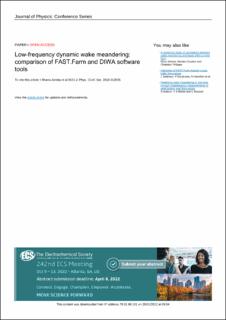Low-frequency dynamic wake meandering: comparison of FAST.Farm and DIWA software tools
Peer reviewed, Journal article
Published version
Permanent lenke
https://hdl.handle.net/11250/2991699Utgivelsesdato
2021Metadata
Vis full innførselSamlinger
- Publikasjoner fra CRIStin - SINTEF AS [5649]
- SINTEF Industri [1534]
- SINTEF Ocean [1384]
Originalversjon
Journal of Physics: Conference Series (JPCS). 2021, 2018, 012005, 12. 10.1088/1742-6596/2018/1/012005Sammendrag
Most of the global dynamic response models used today for the design of wind turbines are based on the aero-hydro-servo-elastic analysis of one single turbine. However, research on bottom- fixed offshore wind turbines has shown that interactions among turbines in a farm influence both the power production and the structural loading. Furthermore, floating wind turbines (FWTs) are sensitive to low-frequency variations, and therefore to wake meandering perturbations. In the current work, we use the Dynamic Wake Meandering (DWM) model as implemented in DIWA and FAST.Farm, to study the low-frequency content of the meandering at a target turbine placed 8 diameters downstream. At frequencies in the range of the natural frequencies of rigid body motions of semisubmersible floaters, the two models yield different results. These differences are seen for every wind speed and wind turbine model, even though they decrease as the wind speed increases. The observed differences may affect low-frequency motions and consequently mooring system design.

